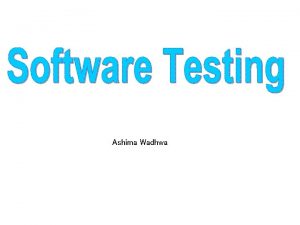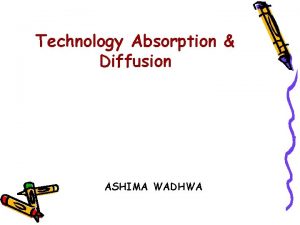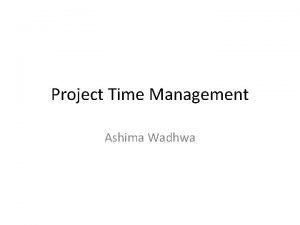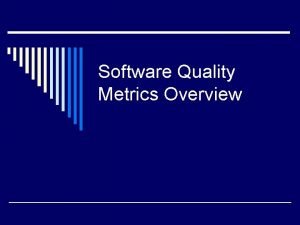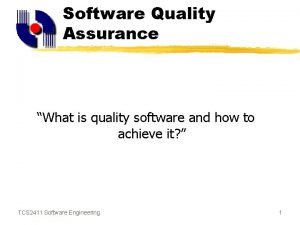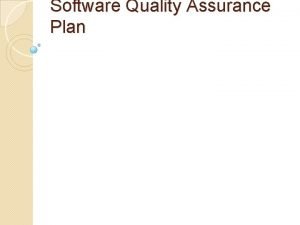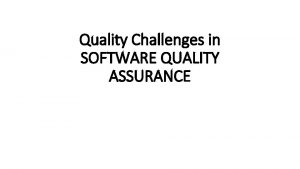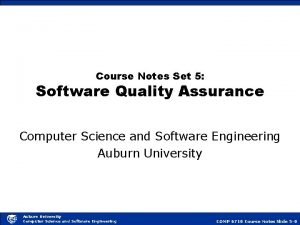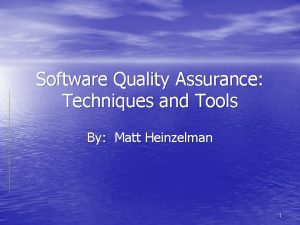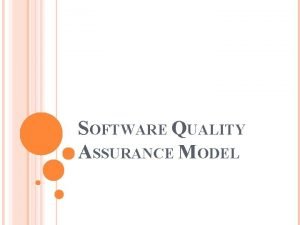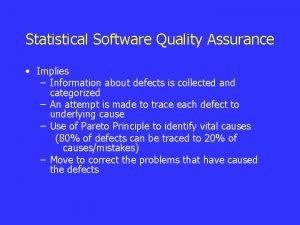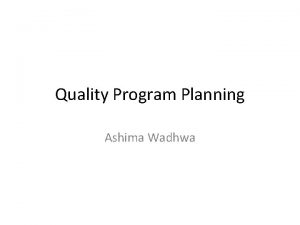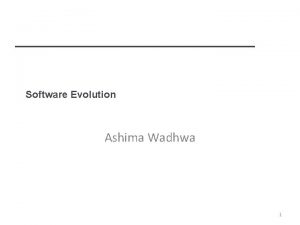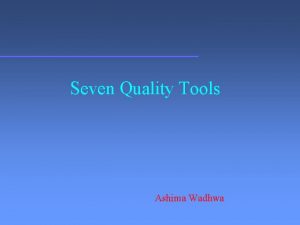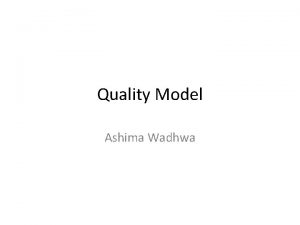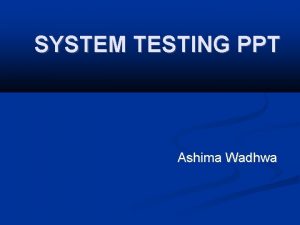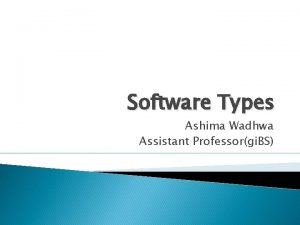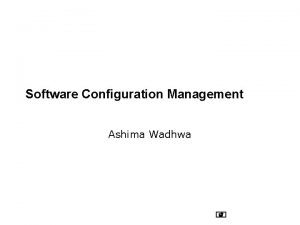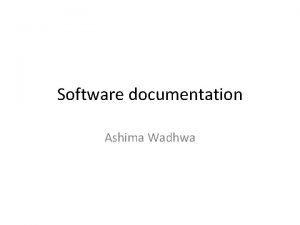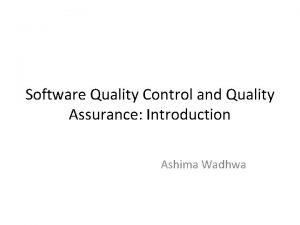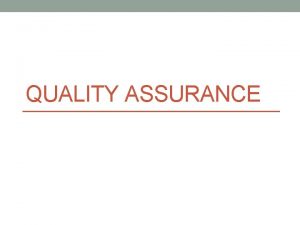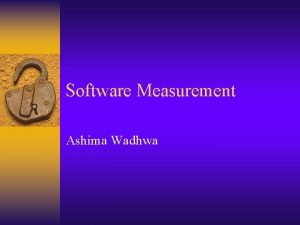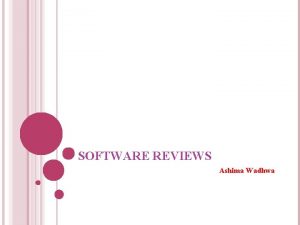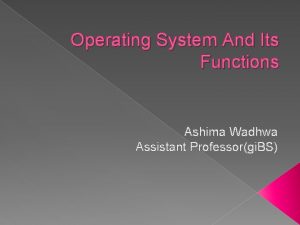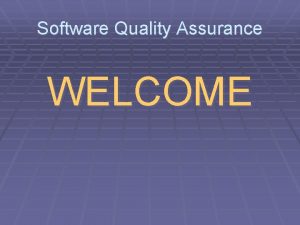System Implementation Ashima Wadhwa Software Quality Assurance What



















- Slides: 19

System Implementation Ashima Wadhwa

Software Quality Assurance • What is “quality”?

Software Quality Assurance • What is “quality”? • IEEE Glossary: Degree to which a system, component, or process meets (1) specified requirements, and (2) customer or user needs or expectations

Software Quality Assurance • What is “quality”? • IEEE Glossary: Degree to which a system, component, or process meets (1) specified requirements, and (2) customer or user needs or expectations • ISO: the totality of features and characteristics of a product or service that bear on its ability to satisfy specified or implied needs

Software Quality Assurance • An alternate view of Quality: • • • is not absolute is multidimensional, can be difficult to quantify has aspects that are not easy to measure assessment is subject to constraints (e. g. , cost) is about acceptable compromises criteria are not independent, can conflict

Software Quality Assurance • Quality Criteria include: • • • correctness efficiency flexibility integrity interoperability maintainability portability reliability reusability testability usability

What is Software Quality Assurance (SQA)? • “Set of systematic activities providing evidence of the ability of the software process to produce a software product that is fit to use” • G. Schulmeyer and J. Mc. Manus, Software Quality Handbook, Prentice Hall, 1998.

What is SQA? • Monitoring processes and products throughout the software development lifecycle to ensure the quality of the delivered product(s) • Monitoring the processes • Provides management with objective feedback regarding process compliance to approved plans, procedures, standards, and analyses • Monitoring the products • Focus on the quality of product within each phase of the SDLC • e. g. , requirements, test plan, architecture, etc. • Objective: identify and remove defects throughout the lifecycle, as early as possible

Software Maintenance

Software Maintenance - Terminology u Software Maintenance – consists of the activities required to keep a software system operational and responsive after it is accepted and placed into production. u Software Evolution – a continuous change from a lesser, simpler, or worse state to a higher or better state u Software Maintainer – person whose mission is to support existing software systems

Software Maintenance Problems u Most computer programs are difficult and expensive to maintain u Software changes are poorly designed and implemented u The repair and enhancement of software often injects new bugs that must later be repaired

Relative Costs of Maintenance 3% Requirements definition 3% Preliminary design 5% Detailed design 7% Implementation 15% Testing 67% Operations and Maintenance

Software Development and Maintenance Differences – Constraints of an existing system » Changes must conform or be compatible with an existing architecture, design and code constraints – Shorter time frames » Development spans 1 or more years or up to 6 months Maintenance spans hours – Available test data » Development creates all test data from scratch Maintenance uses existing test data with regression testing creating new data for the changes

Maintenance Categories u Corrective maintenance u Adaptive maintenance u Perfective maintenance u (Preventative maintenance - Pressman)

Corrective Maintenance u focuses on fixing defects u is a reactive process – i. e. defects generally need to be corrected either immediately or in the near future u Defects – refer to the system not performing as originally intended or as specified in the requirements

Adaptive Maintenance u includes all work related to how the software functions – i. e. relates to enhancing software functionality u includes all changes to meet the evolving needs of the user and the environment – i. e. system changes, additions, insertions, deletions, modifications, extensions and enhancements

Perfective Maintenance u includes all efforts to improve the quality of the software u includes restructuring code, creating and updating documentation, improving reliability or efficiency Maintenance work in the above categories is often performed concurrently

The Maintenance Process u begins when a request for change is initiated by a user u ends when the system passes testing, is accepted by the user and is released for operation u in between there are many activities that must be planned and co-ordinated by use of Change Management

Thank You
 Ashima wadhwa
Ashima wadhwa Technology absorption
Technology absorption Ashima wadhwa
Ashima wadhwa Perform quality assurance
Perform quality assurance Quality control vs quality assurance pmp
Quality control vs quality assurance pmp Pmbok quality assurance vs quality control
Pmbok quality assurance vs quality control Quality assurance model in nursing management
Quality assurance model in nursing management Quality improvement vs quality assurance
Quality improvement vs quality assurance Basic concept of quality control and quality assurance pdf
Basic concept of quality control and quality assurance pdf Backlog management index
Backlog management index Software quality assurance iso standards
Software quality assurance iso standards Sqa plans
Sqa plans Software quality challenges
Software quality challenges Maik nogens
Maik nogens Software quality assurance notes
Software quality assurance notes Software testing and quality assurance theory and practice
Software testing and quality assurance theory and practice Software quality assurance tools and techniques
Software quality assurance tools and techniques Software quality assurance models
Software quality assurance models Statistical quality assurance in software engineering
Statistical quality assurance in software engineering Statistical software quality assurance
Statistical software quality assurance
